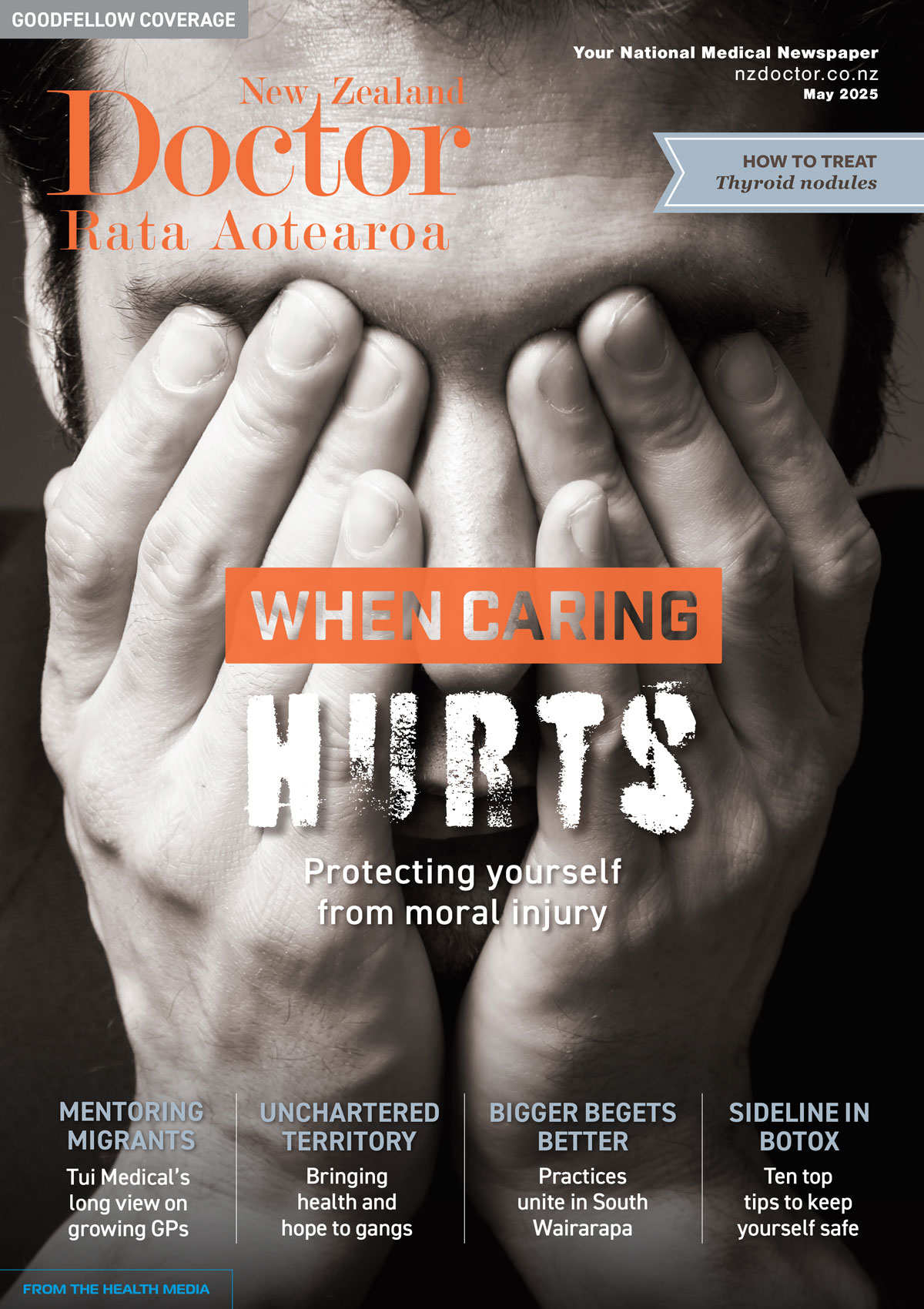Respiratory physician Lutz Beckert considers chronic obstructive pulmonary disease management, including the prevention of COPD, the importance of smoking cessation and pulmonary rehabilitation, and the lifesaving potential of addressing treatable traits. He also discusses the logic of inhaler therapy, moving from single therapy to dual and triple therapy when indicated, as well as other aspects of management
Eye health linked to dementia risk
Eye health linked to dementia risk

A new University of Otago – Ōtākou Whakaihu Waka study has found a link between our eye health and dementia.
Dunedin Multidisciplinary Health and Development Study researchers discovered the blood vessels at the back of the eye – called retinal microvasculature – can show early signs someone is at risk of developing dementia.
Co-lead author Dr Ashleigh Barrett-Young, of the Department of Psychology, says the findings link to previous work by members of the research team, “putting together pieces of a puzzle” when it comes to recognising early signs of dementia.
The findings are too premature to be applied in the real world yet, but research is continuing around the world.
“Treatments for Alzheimer's and some other forms of dementia may be most effective if they’re started early in the disease course.”
Knowing who would benefit from early treatment is crucial, but difficult to do with current testing methods, which she hopes will improve in the future.
Cognitive tests aren’t sensitive enough in the early stages and a person may not be experiencing any decline yet, while other tests, like MRI and PET scanning, are expensive and not widely available.
“In our study, we looked at the retina which is directly connected to the brain,” she says.
“It’s thought that many of the disease processes in Alzheimer's are reflected in the retina, making it a good target as a biomarker to identify people at risk of developing dementia.”
The study was co-led by Dr Aaron Reuben, of the University of Virginia, showcasing one of Otago’s many collaborations with universities around the world.
Published in the Journal of Alzheimer's Disease, researchers used data from eye scans from the Dunedin Study’s age 45 assessment.
It is New Zealand’s longest-running longitudinal study and is considered the world’s most detailed study of human health and development.
The scans reveal narrower arterioles (the small blood vessels that carry blood away from the heart) and wider venules (the smallest veins which receive blood from capillaries), and thinner retinal nerve fibre layers (which carry visual signals from the retina to the brain) were associated with greater dementia risk.
Dr Barrett-Young says this was somewhat unexpected.
“I was surprised that venules were associated with so many different domains of Alzheimer's disease – that suggests that it might be a particularly useful target for assessing dementia risk.”
Despite the findings, she reminds people not to panic.
“This research is still in an early stage, and we can’t predict your future looking at an eye scan,” she says.
“Hopefully, one day we’ll be able to use AI methods on eye scans to give you an indication of your brain health, but we’re not there yet.”
Publication details:
Measures of retinal health successfully capture risk for Alzheimer's disease and related dementias at midlife
Ashleigh Barrett-Young, Aaron Reuben, Avshalom Caspi, Kirsten Cheyne, David Ireland, Jesse Kokaua, Sandhya Ramrakha, Yih-Chung Tham, Reremoana Theodore, Graham Wilson, Tien Yin Wong, Terrie Moffitt
Journal of Alzheimer’s Disease




![Barbara Fountain, editor of New Zealand Doctor Rata Aotearoa, and Paul Hutchison, GP and senior medical clinician at Tāmaki Health [Image: Simon Maude]](/sites/default/files/styles/thumbnail_cropped_100/public/2025-03/Barbara%20Fountain%2C%20editor%20of%20New%20Zealand%20Doctor%20Rata%20Aotearoa%2C%20and%20Paul%20Hutchison%2C%20GP%20and%20senior%20medical%20clinician%20at%20T%C4%81maki%20Health%20CR%20Simon%20Maude.jpg?itok=-HbQ1EYA)
![Lori Peters, NP and advanced health improvement practitioner at Mahitahi Hauora, and Jasper Nacilla, NP at The Terrace Medical Centre in Wellington [Image: Simon Maude]](/sites/default/files/styles/thumbnail_cropped_100/public/2025-03/2.%20Lori%20Peters%2C%20NP%20and%20advanced%20HIP%20at%20Mahitahi%20Hauora%2C%20and%20Jasper%20Nacilla%2C%20NP%20at%20The%20Terrace%20Medical%20Centre%20in%20Wellington%20CR%20Simon%20Maude.jpg?itok=sUfbsSF1)
![Ministry of Social Development health and disability coordinator Liz Williams, regional health advisors Mary Mojel and Larah Takarangi, and health and disability coordinators Rebecca Staunton and Myint Than Htut [Image: Simon Maude]](/sites/default/files/styles/thumbnail_cropped_100/public/2025-03/3.%20Ministry%20of%20Social%20Development%27s%20Liz%20Williams%2C%20Mary%20Mojel%2C%20Larah%20Takarangi%2C%20Rebecca%20Staunton%20and%20Myint%20Than%20Htut%20CR%20Simon%20Maude.jpg?itok=9ceOujzC)
![Locum GP Helen Fisher, with Te Kuiti Medical Centre NP Bridget Woodney [Image: Simon Maude]](/sites/default/files/styles/thumbnail_cropped_100/public/2025-03/4.%20Locum%20GP%20Helen%20Fisher%2C%20with%20Te%20Kuiti%20Medical%20Centre%20NP%20Bridget%20Woodney%20CR%20Simon%20Maude.jpg?itok=TJeODetm)
![Ruby Faulkner, GPEP2, with David Small, GPEP3 from The Doctors Greenmeadows in Napier [Image: Simon Maude]](/sites/default/files/styles/thumbnail_cropped_100/public/2025-03/5.%20Ruby%20Faulkner%2C%20GPEP2%2C%20with%20David%20Small%2C%20GPEP3%20from%20The%20Doctors%20Greenmeadows%20in%20Napier%20CR%20Simon%20Maude.jpg?itok=B0u4wsIs)
![Rochelle Langton and Libby Thomas, marketing advisors at the Medical Protection Society [Image: Simon Maude]](/sites/default/files/styles/thumbnail_cropped_100/public/2025-03/6.%20Rochelle%20Langton%20and%20Libby%20Thomas%2C%20marketing%20advisors%20at%20the%20Medical%20Protection%20Society%20CR%20Simon%20Maude.jpg?itok=r52_Cf74)
![Specialist GP Lucy Gibberd, medical advisor at MPS, and Zara Bolam, urgent-care specialist at The Nest Health Centre in Inglewood [Image: Simon Maude]](/sites/default/files/styles/thumbnail_cropped_100/public/2025-03/7.%20Specialist%20GP%20Lucy%20Gibberd%2C%20medical%20advisor%20at%20MPS%2C%20and%20Zara%20Bolam%2C%20urgent-care%20specialist%20at%20The%20Nest%20Health%20Centre%20in%20Inglewood%20CR%20Simon%20Maude.jpg?itok=z8eVoBU3)
![Olivia Blackmore and Trudee Sharp, NPs at Gore Health Centre, and Gaylene Hastie, NP at Queenstown Medical Centre [Image: Simon Maude]](/sites/default/files/styles/thumbnail_cropped_100/public/2025-03/8.%20Olivia%20Blackmore%20and%20Trudee%20Sharp%2C%20NPs%20at%20Gore%20Health%20Centre%2C%20and%20Gaylene%20Hastie%2C%20NP%20at%20Queenstown%20Medical%20Centre%20CR%20Simon%20Maude.jpg?itok=Z6u9d0XH)
![Mary Toloa, specialist GP at Porirua and Union Community Health Service in Wellington, Mara Coler, clinical pharmacist at Tū Ora Compass Health, and Bhavna Mistry, specialist GP at Porirua and Union Community Health Service [Image: Simon Maude]](/sites/default/files/styles/thumbnail_cropped_100/public/2025-03/9.%20Mary%20Toloa%2C%20Porirua%20and%20Union%20Community%20Health%20Service%20in%20Wellington%2C%20Mara%20Coler%2C%20T%C5%AB%20Ora%20Compass%20Health%2C%20and%20Bhavna%20Mistry%2C%20PUCHS%20CR%20Simon%20Maude.jpg?itok=kpChr0cc)